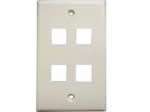Keystone wall plate
Keystone wall plates are used in commercial and industrial buildings to cleanly attach telecommunication cables etc. to a junction box, surface mount box, or a mud ring mounted in the drywall of a building.[1] Keystone wall plates are made to work with many different types of cabling solutions, including coaxial, twisted pair, HDMI, optical fiber, etc. Keystone wall plates are made of plastic and have one to twelve ports. A keystone port is a hole in the wall plate which allows the insertion of a keystone module or other male or female cabling connectors. The most common colors of keystone wall plates are beige and white. Keystone wall plates are commonly made to be compatible with NEMA standard openings and boxes.[2]

4-port Keystone Wall Plate
Further reading
- How To Install Drywall Rings for Keystone Wall Plates Video shows 3 most common drywall rings
gollark: I am at least in the United Kingdom. I have a diagram somewhere.
gollark: What's not?
gollark: How *specific* are these guesses?
gollark: You know you can *ask* which country I live in, right?
gollark: Some stuff wants me to have good English GCSE results for some bizarre reason.
References
- How to Cut Dry Wall for Cabling Installations Video Tutorial Archived 2009-01-23 at the Wayback Machine, - CableSupply.com last accessed 26 May 2009
- Leviton Wall Plate Product Description, - Leviton.com last accessed 26 May 2009
This article is issued from Wikipedia. The text is licensed under Creative Commons - Attribution - Sharealike. Additional terms may apply for the media files.